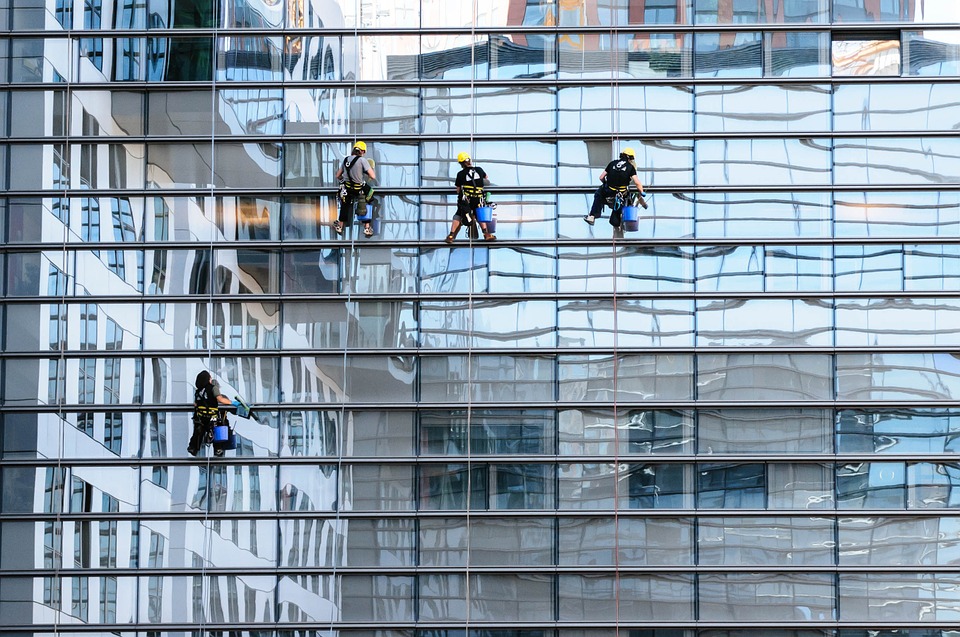Facade access equipment
Contents |
[edit] Introduction
The term ‘facade’ can refer to any predominantly vertical face of a building envelope, such as an external wall. In terms of the built environment, the term ‘access’ refers to the means or ability to approach and/or enter a place.
Facade access equipment is used to allow regular maintenance tasks such as cleaning and repairing surfaces, windows, glazing, cladding and other components of the facade as well as for lifting materials.
[edit] Systems
Facade access is provided by systems that allow crews to perform tasks that are required as part of their cleaning and maintenance responsibilities. Facade access equipment should provide safe access to all parts of the building facade, including hard-to-reach places.
In existing buildings, this equipment may be less than optimal if maintenance requirements were not considered during the construction process. For historic buildings, special facade access strategies and devices may be required, particularly in cases where restrictions may be imposed on projects with listed building or conservation area status.
In new construction projects where facade access will be an ongoing requirement of the building, the type of equipment should be considered at an early stage of the project.
[edit] Temporary or permanent facade access equipment
Temporary equipment can include scaffolding and aerial work platforms. Aerial work platforms may include elevating work platforms, cherry pickers, bucket trucks, mobile elevating work platforms (MEWPs) and so on. See also: Window cleaning.
Permanent facade access may be provided by equipment such as travelling ladders (which can be electronically powered or manually moved), transport systems (such as maintenance monorails), gantries or rope systems with fixed anchors (or abseiling systems).
[edit] Rope access equipment
Recommendations and guidance for the use of rope access systems for work at height conditions is available in BS 7985:2013, Code of practice for the use of rope access methods for industrial purposes. Recommendations and guidance supplementary to BS ISO 22846.
BS 7985:2013 is applicable to the use of rope access systems in buildings where ropes are suspended from - or connected to - the structure and are used as the primary means of access, egress or support and as the primary means of protection against a fall. The standard is applicable to those who use rope access methods and those who commission rope access work (such as building owners and contractors) as well as safety officers.
The information and guidance given in Clause 4, 5 and 12.1 of BS 7985:2013 is of particular relevance to building owners and contractors.
[edit] Suspended access equipment SAE
There are also permanent speciality facade access systems known as suspended access equipment (SAE). This includes cradles, mechanical building maintenance units (BMUs) and other types of platforms that are generally suspended by steel wire ropes from a securely mounted overhead structure (also known as a suspension rigs).
SAEs can normally be raised and lowered and moved laterally across the façade of a building. Recommendations and guidance for SAE systems is available in BS 6037-1:2017, Planning, design, installation and use of permanently installed access equipment. Code of practice - Suspended access equipment. The standard can be used by building owners, facility managers, safety officers, architects, structural and construction engineers, and specifiers to ensure the provision of safe equipment in construction, refurbishment and facilities management.
[edit] Related articles on Designing Buildings
- Building services.
- Don’t Look Down! – Skyscraper window cleaning through the ages.
- Façade.
- Facade cleaning.
- Facade maintenance.
- Roofing repairs.
- Safety in high places.
- Work at height.
- Work package bill of quantities.
[edit] External resources
- BSI, BS 6037-1:2017, Planning, design, installation and use of permanently installed access equipment. Code of practice - Suspended access equipment.
- BSI, BS 7985:2013, Code of practice for the use of rope access methods for industrial purposes. Recommendations and guidance supplementary to BS ISO 22846.
Featured articles and news
Architects, architecture, buildings, and inspiration in film
The close ties between makers and the movies, with our long list of suggested viewing.
SELECT three-point plan for action issued to MSPs
Call for Scottish regulation, green skills and recognition of electrotechnical industry as part of a manifesto for Scottish Parliamentary elections.
UCEM becomes the University of the Built Environment
Major milestone in its 106-year history, follows recent merger with London School of Architecture (LSE).
Professional practical experience for Architects in training
The long process to transform the nature of education and professional practical experience in the Architecture profession following recent reports.
A people-first approach to retrofit
Moving away from the destructive paradigm of fabric-first.
International Electrician Day, 10 June 2025
Celebrating the role of electrical engineers from André-Marie Amperè, today and for the future.
New guide for clients launched at Houses of Parliament
'There has never been a more important time for clients to step up and ...ask the right questions'
The impact of recycled slate tiles
Innovation across the decades.
EPC changes for existing buildings
Changes and their context as the new RdSAP methodology comes into use from 15 June.
Skills England publishes Sector skills needs assessments
Priority areas relating to the built environment highlighted and described in brief.
BSRIA HVAC Market Watch - May 2025 Edition
Heat Pump Market Outlook: Policy, Performance & Refrigerant Trends for 2025–2028.
Committing to EDI in construction with CIOB
Built Environment professional bodies deepen commitment to EDI with two new signatories: CIAT and CICES.
Government Grenfell progress report at a glance
Line by line recomendation overview, with links to more details.
An engaging and lively review of his professional life.
Sustainable heating for listed buildings
A problem that needs to be approached intelligently.
50th Golden anniversary ECA Edmundson apprentice award
Deadline for entries has been extended to Friday 27 June, so don't miss out!
CIAT at the London Festival of Architecture
Designing for Everyone: Breaking Barriers in Inclusive Architecture.
Mixed reactions to apprenticeship and skills reform 2025
A 'welcome shift' for some and a 'backwards step' for others.

























